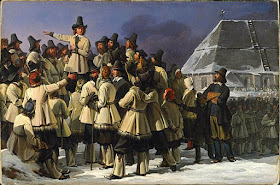Gustav Vasa fought Denmark to gain Sweden's independence from the Kalmar Union. Explore the early beginnings of the founder of the Vasa Dynasty.
Swedish Independence
Swedish Independence
War with Denmark ravaged Sweden as the country attempted to break from the Danish yolk and their Kalmar Union. Elected regents continuously fought for their Sweden’s independence from the Danes and local factions willing to stay with the unfair Union. Sten Sture the Younger faced Denmark’s King Christian II who resolved to keep the Union intact with himself as the ruler.
By
1520, Christian took the upper hand in the war. Sten Sture the Younger fell to
his wounds in Lake Malar and Christian II marched triumphantly to Stockholm. He
then supported pro-Union Bishop Gustav Trolle in taking revenge against the
Swedish patriots. Lines of clerics and noblemen who “betrayed” Christian and
the Union were executed in what became known as the Stockholm Bloodbath. They
thought that with the massacre Swedish resistance would end. They were wrong.
In
the Norwegian-Swedish border province of Dalarna, a son of a noble and a
supporter of Sten Sture rose up to reawaken the resistance against the Danes
and establish Swedish independence. Gustav Eriksson Vasa restarted the war that
ended with the establishment of a dynasty that later brought the country’s
golden age.
 |
| Stockholm Bloodbath and the Desecration of Sten Sture's Grave |
The Young Fighter
Born in May 12, 1496, Gustav Ericksson Vasa was the son of Erik Johansson Vasa and Cecilia Mansdotter Eka, both coming from families well-connected and influential. His father Erik served as a state councilor while his family, the Vasa, claimed proudly their ancestry from St. Erik and St. Bridget of Sweden. Her mother Cecilia had a family connected to the famous Sture family epitomize with the marriage of her half-sister Cristina Gyllenstierna to Sten Sture the Younger.
 |
| Erik Johansson Vasa |
When
conflict with the Danes began, the Vasa family aligned themselves with the
Stures. Gustav himself took up arms and fought with Sten Sture the Younger in
the Battle of Brannkyrka on July 27, 1518 where the Swedes won an outstanding
victory. It was said Gustav distinguished himself by serving as the holder of
the Swedish banner during the battle.
The
Swedish victory in the Battle of Brannkyrka and several more that followed
forced Danish King Christian to sue for peace. The Swedes sent 6 nobles to
Christian II’s camp as an assurance of a truce while both sides decide where official
negotiations should be held. Surprisingly for Sten Sture, when he waited for
Christian to appear for the talks, the dubious King sailed back to Denmark
along with the 6 nobles including Gustav Vasa.
For
about a year Gustav stayed in a Danish castle living comfortably, but the news
of Christian’s plans to restart his conquest of Swedish worries him and made
him determined to return home. So in September 1519 disguising as a peasant, he
escaped Denmark and made his way to Lubeck, the home of the powerful and
wealthy Hanseatic League that was hostile to Denmark and Christian II as well.
Gustav asked the League for military support in vain but they gave him
protection from Christian II.
 |
| Battle of Brannkyrka |
 |
| Christian II |
In
January 1521, however, situation changed. The people of Mora sought Gustav as
their leader against their armed rebellion against the conquering Danes. Gustav
agreed and soon he became the leader of the fight for independence in Dalarna.
He along with his thousand man army then marched into the surrounding provinces
to call out their fellow countrymen to war. Many joined and he organized them
into a strictly disciplined army ready to face the powerful Danish army. He
captured the city of Vasteras that served as a base for the Danes despite
facing overwhelming superior opponent.
Afterwards,
the army divided itself and went to different provinces to harass the Danes and
besieged many of their strongholds, including Stockholm itself. One by one,
these camps surrendered. Christian avenged his defeat by sending Gustav’s
mother to Denmark imprisoned and badly treated.
Gustav’s
leadership of the fight against the Danes led to the convening of the Riksdag
in Vadstena where the representatives of the estates of nobility, clergy,
burghers, and peasants elected him as the new Regent of Sweden succeeding Sten
Sture the Younger. In 1522, he sought once again the military support of his
friends in the Hanseatic League which finally agreed to lend their support by
sending warships to besiege Stockholm by sea.
 |
| The Entry of King Gustav Vasa of Sweden into Stockholm by Carl Larsson |
The
war continued to progress in 1523 with situations in Denmark favoring Gustav’s
position. The uncle of Christian II, Frederick, and with the support of the
Danish nobles took over Copenhagen and forced Christian to abdicate. With the
fall of Christian came the end of the conflict between Sweden and Denmark.
On
June 6, 1523, the Riksdag once again convened in Strangnas and declared Gustav
Eriksson Vasa as King of Sweden. By then, Gustav changed from a freedom fighter
to a statesman and ahead him laid numerous challenges to his rule.
See also:
Who was Gustav I Vasa? (Part 2)
Bibliography:
Nilsson, Victor. History of Sweden. New York: The Co-operative Publication Society, 1899.
Stefansson, Jon. The Story of the Nations: Denmark and Sweden with Iceland and Finland. New York: G.P. Putnam's Sons, 1917.
Svanstrom, Ragnar & Carl Fredrik Palmstierna. Short History of Sweden. New York: Oxford University Press, 1934.
See also:
Who was Gustav I Vasa? (Part 2)
Bibliography:
Nilsson, Victor. History of Sweden. New York: The Co-operative Publication Society, 1899.
Stefansson, Jon. The Story of the Nations: Denmark and Sweden with Iceland and Finland. New York: G.P. Putnam's Sons, 1917.
Svanstrom, Ragnar & Carl Fredrik Palmstierna. Short History of Sweden. New York: Oxford University Press, 1934.

No comments:
Post a Comment